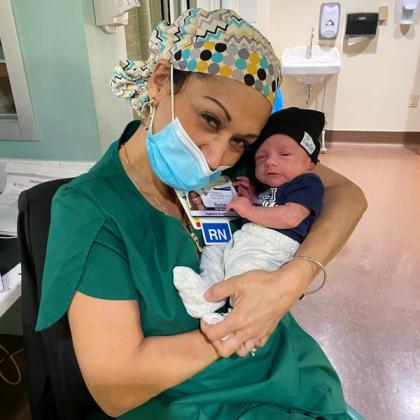Boasting a united front at city and county chambers throughout Southeast Texas over the last couple months, local health care workers voiced concerns over a spike in violence enacted against health care employees, especially nurses. Joining in the health care worker plight for a workplace safe from assaultive behavior, elected officials are also signing on to urge legislation that will protect medical professionals working in the health care field.
During a Jan. 26 ceremony hosted by The Medical Center of Southeast Texas, Emergency Services and Education Director Keri Reeves revealed proclamations of support for prevention of workplace violence against health care workers from elected officials from Beaumont, Port Arthur and Groves.
Reeves, who also serves as president of the Golden Triangle Emergency Nurses Association (GTENA), said data from 2022 reveals that nurses continue to be assaulted “at a rate of 1,739 per month, 57 every day and one every two hours.”
In response to the numbers GTENA data details, Port Arthur Mayor Thurman Bartie signed a city proclamation announcing Jan. 17 as “Violence in the Workplace Day,” a day set aside to commit support for initiatives and legislation at the local, state and national level to deter individuals committing acts of violence against health care workers.
Reeves said that local health care workers are frequently the victims of assaultive behavior – some of the most heinous accounts in the field making headlines statewide. The Oct. 22, 2022, fatal shooting of two health care workers in a Dallas hospital illustrates the growing violence being seen at hospitals across America. At the time, it was the third deadly shooting at a U.S. hospital complex in a four-month timespan.
According to the Association of American Medical Colleges (AAMC), threats against health care workers are rising. The Bureau of Labor Statistics reports that the rate of injuries from violent attacks against medical professionals grew by 63% from 2011 to 2018, and hospital safety directors say that aggression against staff escalated as the COVID-19 pandemic intensified in 2020.
In a survey in Spring 2022 by National Nurses United, the nation’s largest union of registered nurses, 48% of the more than 2,000 responding nurses reported an increase in workplace violence – more than double the percentage from a year earlier.
AAMC reports that the reasons for aggression vary: patients’ anger and confusion about their medical conditions and care; grief over the decline of hospitalized loved ones; frustration while trying to get attention amid staffing shortages, especially in nursing; delirium and dementia; mental health disorders; political and social issues; and gender and race discrimination.
Violence publicized
Misty Dantin, an emergency room Registered Nurse at Christus St. Elizabeth Hospital in Beaumont and president-elect of GTENA, said violence against health care workers is “more publicized” than it had been in the past – although the trend of health care worker assault isn’t a completely new fad.
“What I think we are seeing is an increase in nurses speaking out about it,” Dantin said. “We’ve assumed it was part of our jobs and something that we have to deal with. What is turning the tables is that we are finally saying this is something we shouldn’t have to deal with and it’s something that needs to be addressed.
“It’s not part of our job. Dealing with confused patients and things like that, that’s one thing, but we’re standing up about patients that knowingly put their hands on nurses, threaten their life. These are things we deal with all the time.”
Dantin noted that violence against health care workers has always existed, but it has definitely seen an increase after the COVID-19 pandemic.
“I don’t know if it’s directly related to the pandemic, but it has been more noticeable,” Dantin said, adding that she’s also witnessed an uptick in mental health cases, depression and other mental issues. “I don’t know if that comes into play in the hospitals, and we become the focus of aggression – but, a lot of the violence occurs when people come into a hospital.
“They’re expecting or looking for a certain treatment and their course of action doesn’t call for that type of treatment, or whatever they are looking for. Then the nurses, doctors or providers become the focus of their anger.”
Screening tools
Dantin said hospitals have screening tools to help health care workers recognize if a person has the potential to be aggressive or violent.
“It’s their behavior; it’s their speech; it’s their eyes, and different things on a checklist that we can look at and screen it,” the nurse explained. Prior experience also has a lot to do with it. “If the person has had a history of violence, we let our security team know immediately when they are on campus.”
Dantin said there are surveillance cameras throughout the inside and outside of the hospital.
“They are always watching,” Dantin said, which has helped thwart escalating incidents, as well as prosecute offenders. And, according to Dantin, with cities now committing to offer as much support as they can, the police response has been more proficient than ever. “The police are being very responsive and very supportive. They are finally standing up and taking this seriously.”
Stephanie Harris, director of Marketing and Communications for Baptist Hospitals of Southeast Texas in Beaumont, said the hospital has more than a dozen people on its security team, as well as Beaumont Police Department officers, in the emergency room area. Harris noted Baptist Hospital also has inside and outside surveillance cameras.
Legislation
In June 2013, any assault on any emergency room personnel was changed from a misdemeanor to a third-degree felony. Dantin, who is also the Workplace Violence Committee chair for the State of Texas Emergency Nurses Association, noted that the state group is trying to get the law changed from only covering “any emergency room personnel” to actually covering ALL health care workers.
“That’s something that’s on our radar that we want to start working on,” she said.
Dantin said a proposed Workplace Violence Bill in the Texas Legislature passed the House, but not the Senate.
“We’ve reached out to Dade Phelan (Speaker of the Texas House of Representatives) and he is planning to meet with us to discuss the issue,” Dantin said, hopeful 2023 will be the year the state steps in to protect its health care workers. “This year, it’s proposed as Senate Bill 240. (Phelan) is in support of us and he wants to know more about it so he can present it, explain it, and get it passed this year.”
In Congress, the proposed Safety from Violence for Healthcare Employees Act would increase penalties for assault and intimidation against health care workers, while a budget bill would provide $5 million in grants for health care provider safety and security.
A long time coming
Just over a year ago, nurses and hospital executives warned of the escalating violence in medical settings noted throughout Texas and the U.S. – both in large and small establishments.
“Our staff have been cursed at, screamed at, threatened with bodily harm and even had knives pulled on them,” said Jane McCurley, chief nursing executive for Methodist Healthcare System, speaking at a press conference five days after a violent incident in the hospital’s children’s ER. “It is escalating. … It’s just a handful at each facility who have been extremely abusive. But there is definitely an increasing number of occurrences every day.”
According to Dantin, when a health care worker is injured on the job by a patient at St. Elizabeth Hospital, the Human Resources Department has an Employee Assistance Program.
“It’s not just for medical treatment, but a lot of nurses get PTSD (post-traumatic stress disorder) and they may need counsel after certain events happen,” she said. “They’re scared to come back to work, scared for their safety or whatever reason.”
Dantin said she’s found a lot of nurses are leaving the health care field because of the aggression and violence.
“It just raises burnout and people just don’t want to deal with it,” she said. “They just leave nursing altogether. I hope to get this all out in the forefront and maybe they will come back. Maybe it will prevent other employees from getting burned out and leaving.”
Workforce shortages
The Texas Health and Human Services Commission (HHSC) announced Jan. 24 it is increasing salaries and starting pay at state hospitals and state-supported living centers to help with crucial staffing needs, maintain competitive wages and bring hospital beds back online. More than 700 state hospital beds are offline due to workforce challenges, according to the state agency.
HHSC is looking to fill approximately 1,805 vacancies in state hospitals and 2,137 in state supported living centers alone.
At community hospitals, health care employees that were once celebrated for their dedication to the field amid a global pandemic are now dodging punches and begging for the people they serve to stop the violence.
“We were seen as health care heroes and our community responded with love and support, food and gifts, drive-by parades, buses and motorcycles and airplanes, and we felt so much love and support. It gave us the courage to go in and face our own fears of the unknown in the beginning,” McCurley said as she addressed violence committed against staff at her own hospital. “Today, those health care workers are experiencing abusive behavior by patient families. It’s unfathomable that it’s occurring, and it has to stop.”
-Dannie Oliveaux, Staff Reporter




